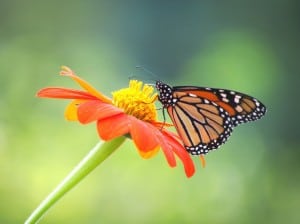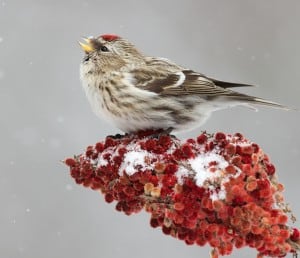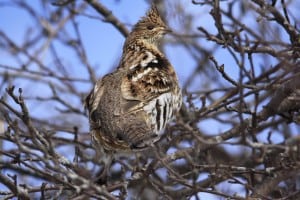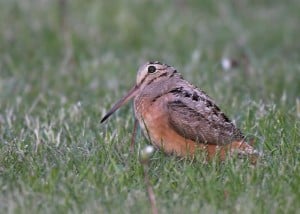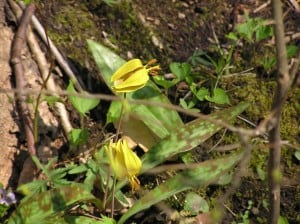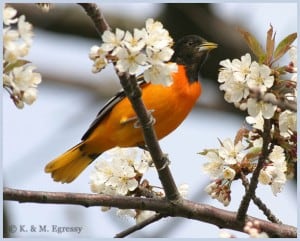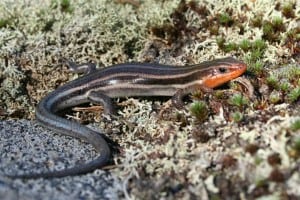Against a backdrop of more dire climate change reports, we can still enjoy the arrival of spring
Following on the heals of last fall’s International Panel on Climate Change report, which stated that global warming must be limited to 1.5-degrees Celsius to avoid a non-stoppable, runaway climate crisis, two other dire climate reports were released in the past month. Both reports highlighted the speed and intensity at which climate change is progressing.
In March 21, a report commissioned by the Chicago-based Environmental Law & Policy Center was released explaining that the Great Lakes region – the region in which Peterborough and the Kawarthas is located – is warming faster than the rest of the US. Since 1910, the annual mean air temperature in the region increased 0.89 C compared to 0.67 C for the rest of the country. The report explained that as air warms, it holds more moisture, causing more extreme storms and flooding, while also degrading water quality, worsening erosion and posing tougher challenges for farming. Drinking water quality may also be degraded by more releases of untreated sewage during heavy storms and nutrient runoff that feed harmful algae blooms, some toxic. Warmer temperatures will produce less ice cover, boosting evaporation and pushing lake levels down. As for temperature, summers are expected to become hotter and drier. Heat waves with days exceeding 32 C are likely to become more common, posing risks for elderly people and children with asthma.
As if this wakeup call was not enough, on April 1, federal scientists and academics warned that Canada’s climate is warming at twice the rate of the rest of the world and that Northern Canada is warming even more quickly, nearly three times the global rate. Three of the past five years have been the warmest on record, the authors said. According to Chris Derksen, a research scientist with Environment and Climate Change Canada, the changing climate has meant extreme heat, less extreme cold, longer growing seasons, rapidly thinning glaciers, warming and thawing of permafrost, and rising sea levels in Canada’s coastal regions.
Against this frightening backdrop, it is no wonder that the timing of events in nature are being affected. I would still like to remind readers, however, of the mileposts of spring’s progression. Regardless of what the weather throws at us, the order of the events, which are listed chronologically, should remain the same.
April
· It’s time to start indoor sowing of annuals for your pollinator garden. Some great species include Mexican Sunflower (Tithonia), Common Sunflower (Helianthus annuus), catnips (Nepeta), salvia and zinnias.
· The Peterborough Field Naturalists hold Sunday Morning Bird Walks throughout April, May, and June. Meet Sundays at 8:00 a.m. in the north parking lot of the Riverview Park and Zoo. From there participants carpool to various birding hot spots as determined by the leader. Outings generally last about 3 to 4 hours. Bring binoculars and some change to help out with gas.
· Don’t be too surprised if a half‑crazed robin or cardinal starts pecking at or flying up against one of your windows or even the side-view mirror of your car. Being very territorial birds, they instinctively attack other individuals of the same species – in this case, their reflection!
· With a bit of work, you should be able to find a dozen or more species of migrating waterfowl this month. Some hotspots include Little Lake, the Otonabee River and the Lakefield Sewage Lagoon on County Road 33.
· April is a busy time for feeders. In addition to Dark-eyed Juncos, Song Sparrows, Common Grackles and resident species like chickadees and cardinals, small numbers of Common Redpolls are now showing up in Peterborough backyards, adding a splash of much needed colour. Later in the month, White-throated Sparrows will be moving through. May will bring White-crowned Sparrows and sometimes rarer species like Lincoln’s Sparrows.
· On April 21 from 1 to 5 p.m., discover Harper Park, a provincially significant wetland within our City boundaries. Learn about the history of the site, its interesting groundwater-based ecosystems, heritage trees, and vernal pools. Wear waterproof footwear and bring binoculars.
· When water temperatures reach 7 C, Walleye begin to spawn. Along with suckers, they can sometimes be seen spawning at night at Lock 19 in Peterborough or below the pedestrian bridge in Young’s Point. Take along a strong‑beamed flashlight.
· The Peterborough Garden Show runs from April 26 to 28 at the Kawartha Trades and Technology Centre at Fleming College, 599 Brealey Drive. On the Sunday afternoon at 2:00 pm, butterfly expert and author Carol Pasternak will present “Drama in the Butterfly”. Carol’s book, How to Raise Monarch Butterflies: A Step-by-Step Guide for Kids, will be available ($10) after the presentation. Carol will explore the secret lives of insects in your yard or nearby natural area. From 12 pm to 12:30 pm, she will also present a butterfly workshop suitable for ages six and up.
· The muffled drumming of the Ruffed Grouse is one of the most characteristic sounds of April. The birds drum to advertise territorial claims and to attract a female.
· If the weather is mild, local wetlands come alive in early April with the clamorous calls of countless frogs. The first voice usually heard is that of the Chorus Frog. To learn amphibian calls, go to naturewatch.ca. In the menu at the top of the page, click on FrogWatch.
· The courtship flight of the American Woodcock provides nightly entertainment in damp, open field habitats such as fields at the Trent Wildlife Sanctuary. Listen for their nasal “peent” call which begins when it’s almost dark
May
· A variety of interesting butterflies is already on the wing as May begins. These include the Compton Tortoiseshell, the Eastern Comma and the Mourning Cloak. Petroglyphs Provincial Park is a great destination for butterfly watching.
· On May 8 at 7:30 pm, Ellen Jamieson, a master’s student at Trent University and a Peterborough native, will present a talk to the Peterborough Field Naturalists entitled “A Day in the Life of a Shorebird in South Carolina”. Shorebirds undergo one of nature’s most fascinating migrations, but they are in trouble with many populations experiencing drastic declines. The talk takes place at the Camp Kawartha Environment Centre at 2505 Pioneer Road.
· The yellow-gold flowers of Marsh Marigolds brighten wet habitats in early May. By mid-month, White Trilliums blanket woodlots throughout the Kawarthas. A closer look will reveal numerous other wildflowers, too, like Yellow Trout Lily.
· With many species nesting, try to keep your cat indoors. It’s no wonder so few baby robins ever make it to adulthood in Peterborough any more.
· The first Ruby-throated Hummingbirds usually return on about May 5, so be sure to have your nectar feeders up and ready to greet them.
· The long, fluid trills of the American Toad can be heard day and night. They are one of the most characteristic sounds of early May. Later in the month, Gray Treefrogs serenade us with their slow, bird-like musical trills.
· The damp morning air is rich with the fragrance of Balsam Poplar resin, a characteristic smell of spring in the Kawarthas.
· If you are looking for pollinator plants for your garden, don’t miss the Peterborough Horticultural Society Plant Sale on Saturday May 11, 2019, from 9 – 11 am at Westdale United Church, 1509 Sherbrooke St.
· Mid-May sees the peak of songbird migration with the greatest numbers of warblers, vireos, thrushes, orioles, flycatchers and other neo-tropical migrants passing through.
· That large, streaked sparrow-like bird at your feeder is probably a female Rose-breasted Grosbeak. Males are black and white, with a red breast. Just in from Costa Rica, grosbeaks are attracted to sunflower seeds. Watch, too, for Baltimore Orioles and maybe even an Indigo Bunting.
· The showy, yellow and black Canadian Tiger Swallowtail butterfly appears by month’s end and adds an exotic touch to our gardens.
June
· In downtown Peterborough and Lakefield, Chimney Swifts will be putting on quite a show. Pairs can be observed in courtship flight as they raise their wings and glide in a V position.
· Watch for turtles laying their eggs in the sandy margins of roadsides and rail-trails. Remember to slow down when driving through turtle-crossing zones and, if safe, help the reptile across the road.
· The first Monarch butterflies usually appear in the Kawarthas in June. Make sure you have some milkweed in your garden on which they can lay their eggs. In January, World Wildlife Fund Mexico announced that the total forest area occupied by overwintering Monarch colonies this winter covered 6.05 hectares, a 144% increase from the previous season!
· Five-lined Skinks, Ontario’s only lizard, mate in early June and are therefore more active and visible. Look for them on sunny, bare, bedrock outcroppings with deep cracks such as near the Visitors Centre at Petroglyphs Provincial Park.
· The Summer Solstice occurs on Friday, June 21 at 11:54 am. The sun will rise and set farther north than on any other day of the year. Celebrate this profound celestial event with your family.
ARGUMENTS FOR ACTION ON CLIMATE CHANGE
Some people argue that Canada is such a small greenhouse gas emitter that it is irrelevant whether we cut our emissions or not. You can counter this by pointing out that: 1. Canada is actually the world’s 10th biggest emitter, ahead of even France and Brazil. 2. On a per capital basis, Canadians are the fourth largest emitters in the world – about the same as Americans and quadruple that of Swedes who live in a similar climate. 3. No one argued during WW II that given our small population, any contribution by Canada to the war effort would be meaningless. Sixteen times more Americans fought than Canadians, but Canada still played a very significant role in the war. The same logic applies to climate change. We have a moral imperative to do our part in this fight, which requires no less than a war-level response. What moral weight would we have to tell less fortunate countries to cut emissions if we are doing very little ourselves?
